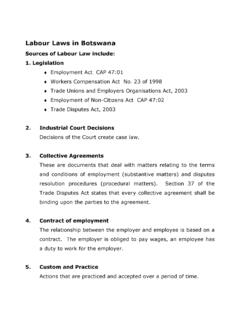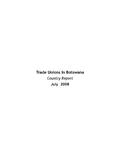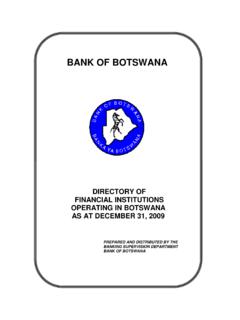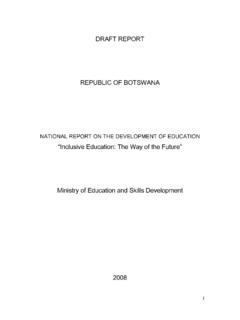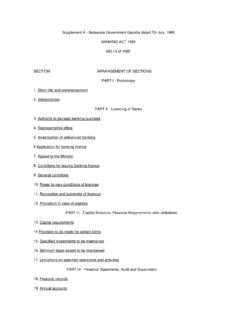Transcription of COUNTRY REPORT TO THE FAO INTERNATIONAL TECHNICAL ...
1 botswana : COUNTRY REPORTTO THE FAO INTERNATIONALTECHNICAL CONFERENCEON PLANT GENETIC RESOURCES(Leipzig,1996)Prepared by:L . M. MazhaniGaborone, June 1995 botswana COUNTRY report2 Note by FAOThis COUNTRY REPORT has been prepared by the national authorities in thecontext of the preparatory process for the FAO INTERNATIONAL TechnicalConference on Plant Genetic Resources, Leipzig, Germany, 17-23 REPORT is being made available by FAO as requested by the InternationalTechnical Conference. However, the REPORT is solely the responsibility ofthe national authorities. The information in this REPORT has not been verifiedby FAO, and the opinions expressed do not necessarily represent the views orpolicy of designations employed and the presentation of the material and maps inthis document do not imply the expression of any option whatsoever on thepart of the Food and Agriculture Organization of the United Nationsconcerning the legal status of any COUNTRY , city or area or of its authorities.
2 Or concerning the delimitation of its frontiers or COUNTRY report3 Table of contentsCHAPTER FARMING SEED PRODUCTION7 CHAPTER 2 INDIGENOUS PLANT GENETIC FOREST GENETIC WILD RELATIVES OF CROP DISTRIBUTION OF WILD LANDRACES AND OLD CULTIVARS13 CHAPTER 3 NATIONAL CONSERVATION IN SITU EX SITU UTILIZATION OF STORAGE EVALUATION AND CHARACTERIZATION17 CHAPTER 4 CROP IMPROVEMENT SORGHUM IMPROVEMENT GROUNDNUTS IMPROVEMENT GRAIN LEGUME IMPROVEMENT SEED DISTRIBUTION19 botswana COUNTRY report4 CHAPTER 5 NATIONAL NATIONAL LEGISLATION21 CHAPTER 6 REGIONAL AND INTERNATIONAL UNITED NATION NATIONAL CONCLUSION23 References24 botswana COUNTRY report5 CHAPTER LANDB otswana is bounded by the Republic of South Africa on the southeast, byZambia and Zimbabwe on the north and east and by Namibia on the west(Map 1).
3 The altitude of botswana is between 600 and 1,400 metres. Of thetotal land of 582,000 square kilometres, 85 percent consists of Kgalagadisands covered with low thornbush vegetation. The soils of the eastern portionhave some clay content. However, these soils are generally hard and clodforming, with a high bulk density and a strong tendency towards surfacecrusting. Natural fertility is low, particularly in phosphorus (Sims, 1981).The eastern parts of the COUNTRY , also has approximately 10,000 hectares ofirrigable soils mainly along COUNTRY is divided into freehold land (being used for crop and livestockproduction), communal land which is controlled by Land Boards and Stateland which is made up of forests and game reserves. The land use pattern canbe summarized as follows:Table 1 Land Use PatternType of useArea (km)ArableGrazing fencedunfencedSwamp and open waterForestsNational Parks, game reservesUrban and industrial13,60029,300410,53024,0003,200 100,500600 botswana COUNTRY CLIMATET emperatures are highest, and are most uniform, during the peak of thesummer (December - January).
4 Frost occurs occasionally throughout easternBotswana during the winter (April - July). Mean monthly maximumtemperatures range between 32oC to 35oC in the summer period and meanmonthly minimum temperatures vary from to 7oC in winter. Solarradiation is not a limiting factor in agricultural production. The humidity isgenerally low (Pike, 1971).Rainfall is limited and variable. Average annual rainfall varies between 650mm in the north to 250 mm in the southwest. Ninety percent of the rainfalls between November and evapotranspiration from the crop exceeds available rainfallthroughout the year and within any rainy periods, there can be gaps inrainfall of several weeks. Rainfall is even highly variable in PEOPLEAt the time of the 1991 Census, botswana had a population of about1,326,796.
5 The majority of the people live in the eastern part of the people live in rural areas but the population living in urban areas FARMING SYSTEMSF arming families traditionally have a permanent home in their respectivevillage, with a temporary house on their arable holdings (which may be 50km away), and another house at a cattle post (communal grazing area) andthey migrate seasonally between the village and the , food production has been the responsibility of the women,while men spend most of their time at the cattle post herding the is a clear distinction between women's and men's activities but this isnot totally rigid and there is a degree of overlap on some operations as well asinstances of each sex doing tasks usually carried out by the other. Mengenerally take major responsibility for land clearing, ploughing and COUNTRY report7 Once ploughing is finished, the men go to the cattle post and the womenremain at the lands and are responsible for weeding, harvesting and threshingof the system of cultivation in botswana is characterized by animal traction inthe form of cattle, although a few farmers use donkeys and tractors.
6 Farmingis mainly mixed, with the majority of small scale farmers engaged in bothcattle and arable farming is carried out in areas of the Okavango swamps whichare seasonally flooded. Planting takes place when floods recedes which may beearly in the rainy season. The depressed areas have soil with high clay contentcompared to surrounding areas, and are in general, considerably more crops and pulses of significance in terms of economic importance orfor domestic consumption include sorghum, maize, millet, cowpeas,sunflower and groundnuts. Crop production is very erratic as it is influencedby rainfall and other factors including the timely availability of droughtpower, and timeliness of critical operations such as ploughing, planting andweeding. The average annual size of the national harvested grain crop rangesbetween 20,000 tonnes in drought years and 116,000 tonnes (1988) in goodyears, out of an annual requirement of 200,000 tonnes.
7 This represent 10and 25 percent of national domestic requirements, the balance SEED PRODUCTIONThe Seed Multiplication Unit of the Department of Agricultural Research isthe sole producer of improved seed for botswana . A seed inspection, testingand quality control programme and legislation is in place. Certified seed ofimproved varieties is produced under contract by commercial farmers. Someseed growers such as the botswana Development Corporation, a parastatalinstitution, have irrigation facilities on their farm to provide supplementaryirrigation when premium price is paid by the Seed Multiplication Unit to its contract seedgrowers. Seed processing is done by the unit at Sebele Research, where aprocessing plant is in distribution in the COUNTRY is done mainly by botswana AgriculturalMarketing Board.
8 A major feature of the seed programme is the free issue ofBOTSWANA COUNTRY report8seed to farmers during droughts. However, in a good year, seed is sold but ata considerably subsidized COUNTRY report9 CHAPTER 2 Indigenous Plant Genetic FOREST GENETIC RESOURCESThe vegetation of botswana consists typically of nine types of tree and bushsavanna with woodland as listed below:1 Shrub Savanna2 Tree Savanna3 Close Tree Savanna on rocky Hills4 Semi-arid Shrub Savanna5 Grass Savanna6 Aquatic Grassland7 Dry Deciduous Forest8 Riparian Forest9 WoodlandAlthough these resources cover over 60% of the COUNTRY , they are relativelyunproductive. The high value forests of potential commercial value are foundmainly in Chobe District. Six forestry reserves have been gazetted and thetwo main species harvested in these areas are Baikiaea plurijuga andPterocarpus angolensis.
9 Most of the timber products are exported, either toZimbabwe or South Africa. Forestry operations are currently regulated byextraction Forestry Act of 1968 specifies the following species as protected trees onState quanzensisBaikiae plurijugaGuibourtia coleospermaPlerocarpus angolensisEntandophragma caudatumAdansonia digitataBerchemia discolorDiospyros mespiliformisBOTSWANA COUNTRY report10 Most deforestation occurs not through logging activities only, but alsothrough collection of wood for fuel and the subsequent environmentaldegradation around villages and towns is very significant. Wood is used for avariety of purposes such as energy, construction, fencing and crafts. In ruralareas in particular, wood is the major source of energy and fencing main Chobe Forestry Block comprises some 5,179 square kilometres,60% of which lies within the Chobe Game reserve.
10 Forests and woodlandsoccur mainly in the Chobe and Ngamiland (Figure 1). Because of damage tothe trees from frequent fires, these natural resources could be wasted ifexploitable timber is not sustainably VELDPRODUCTSV eldproducts are widely used for food and income generation through Mokola palm (Hyphaen ventricosa) which is found around theOkavango and Makgadikgadi pans is used to make baskets. Basketry is amajor source of employment and income in northwest of botswana . Anotherimportant veld product is the grapple (Harpogophytum procumbens) which ispredominantly found in Kgalagadi is harvested by the poor and sold for and other resources such as the Grewia flava provide a major source ofincome for poor sections of the population and therefore they are traditionally veldproducts have been used mainly for subsistencepurposes, more recently commercial uses have developed involving processingin some cases.










